Wieliczka 2022-08-04
The former Wieliczka Rynek railway station.
Geographic coordinates: 49.985N 20.060E.
Currently (2022) there are three railway stations (passenger stops) in Wieliczka: Wieliczka - Market Square - Mine (final stop), Wieliczka Park and Wieliczka Bogucice. There used to be the final stop at Wieliczka Rynek, which this chapter is about.
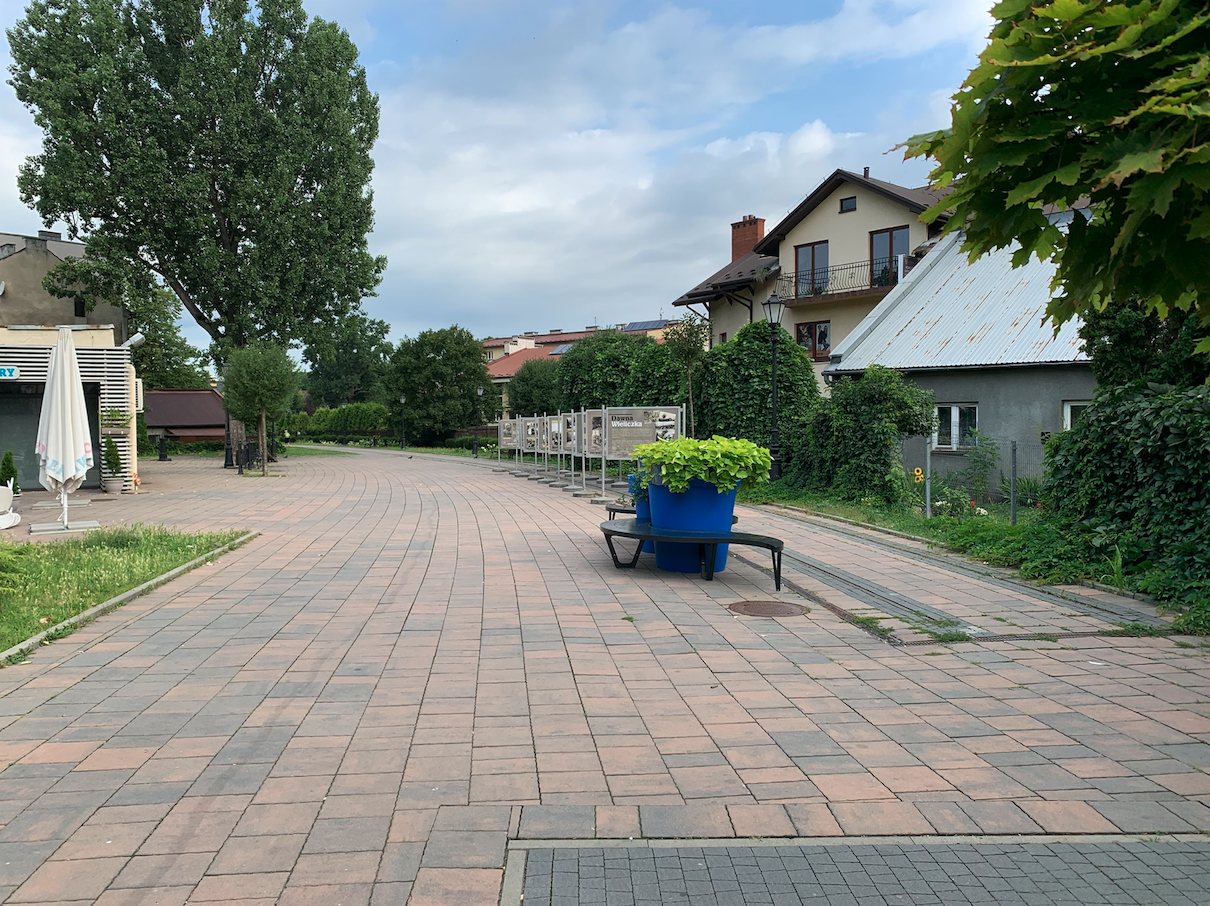
Description of the photo: Railway rails have been left in the promenade. There are photos of the old Wieliczka on the visible boards. On the left, a fragment of the station building from 1960 is visible.
Railway route to Wieliczka.
But for order. The railway line to the salt mine in Wieliczka was planned in 1855. Therefore, in 1856, the Kraków Bieżanów railway station was built on the Kraków - Tarnów railway route. In 1857, the Kraków Bieżanów - Salt Mine railway line was launched. By the way, a railway station was built for a functioning yeast mill. The line to Wieliczka was launched on January 26, 1857. The line belonged to the Austrian State Railways. Poland was then under partitions.
The Wieliczka train station is located in the vicinity of the present Hotel Turówka. Originally, the facility was part of the salt works. The construction of the new salt works was carried out in the period 1812 - 1813, under the supervision of Alojzy Hrdina, the salt master, who came from Ebensee. The building was erected on land belonging to the city, in the area of a medieval farm called "TUR". Hence the name of the facility, Turówka. In the end, the building did not function as a salt brewing house, because the Great World War broke out. The army was stationed in the building, and then it was turned into a warehouse. After 1857, after the construction of the railway line to Wieliczka, a railway siding was connected to the building, which ended with a rotary switch. This made it possible to place the wagon directly at the warehouse door, on the west side. More warehouses were built nearby. In the period 1920 - 1990, the entire upper floor of the building was allocated to housing the employees of the Wieliczka Hall. In 1988, a staff hotel was established here, and in 2006, Hotel Turówka.
In its heyday, the Wieliczka station had five tracks. A railway station was built on it, which still exists, and the station is called Wieliczka Park. Railway traffic was systematically increasing. The trains ended and started running at the present Wieliczka Park station.
The trainsets were combined with passenger and freight cars. Initially, only one pair of trains ran. From 1893, a second pair of trains was put into operation. The third pair of trains appeared after the construction of a link to Tarnów, at the Kraków Bieżanów station. This connector allowed direct travel of trains from Wieliczka to Tarnów. Currently, this liaison is no longer available.
In Austrian times, the authorities were only interested in extracting salt as much as possible and transporting it to Vienna. That is why the city of Wieliczka looked very poor. Most of the houses were wooden. It was only after Poland regained independence that the situation started to improve.
In 1861, a railway siding was built in Wieliczka, leading to the Regis shaft, which at that time was called the Emperor Franz Józef I shaft. The first salt wagons from this station left on October 14, 1861. The wagons were pulled by horse carts. In the following years, railway sidings were led to: the Shaft of Saint Kinga (then Empress Elizabeth), and the Shaft of Tadeusz Kościuszko (then Emperor Józef II). From 1889, salt wagons were hauled by steam locomotives.
In 1927, the trail in Wieliczka was extended to the end station of Wieliczka Rynek. Passenger trains with tourists and residents traveled here. The station was serviced by a motor car, which made it easier to change the direction of travel. There was no turntable or second track at the Wieliczka Rynek station.
The German occupation again degraded the PKP company, and its extension after the Second World War was expensive and long. In 1948, the line was No. 139, and in 1988, No. 121. Currently, it is No. 109.
In 1960, the line to Wieliczka was electrified, which was a great success. Thanks to this, spacious and comfortable EMU trains were directed to the trail, which always ended at the Wieliczka Rynek station. The first electric ETZ squad hit the line on May 29, 1960. In 1965, 18-20 pairs of trains were already running to Wieliczka. Trains started running at the Kraków Główny station. The line No. 109 to Wieliczka was intensively exploited until the end of the 1980s. It ran for freight trains with salt and bricks, and passenger trains, usually EN57. Freight trains in the other direction carried goods such as coal and timber, necessary for the operation of the mine.
In 1992, there was a great failure in the Wieliczka Mine. It consisted in the leakage of huge amounts of water that threatened to flood the entire mine. However, this was not allowed to happen. Modern and efficient pumps, resistant to salt water, were installed and the leak was blocked. This leakage damaged the tracks and the trains had to end their run at the Wieliczka station (Wieliczka Park).
In the following years, salt mining in Wieliczka was completed and freight trains stopped running. The passenger traffic was taken over by private carriers who transported passengers by buses. There were proposals for the liquidation of the line No. 109. In addition, mining damage contributed to the damage to the track. The speed of EMU trains was limited. With the end of salt extraction in Wieliczka, the salt is no longer digged, but the brine brought to the surface goes to the brewhouse, where the salt is recovered.
In 2000, as a result of cuts in rail transport, all passenger connections from Krakow to Wieliczka were suspended. Fortunately, in 2001, rail traffic was restored, mainly due to the intervention of the local government in Wieliczka. At that time, EMUs ran, such as rail buses of the EN81 series, or EN57, EN71.
Modernization of Line No. 109.
On April 4, 2011, PKP Polskie Linie Kolejowe signed a contract with a consortium of Eurovia Polska and Eurovia CS for the modernization of line No. 109. The works included complete replacement of the track, traction network, installation of new SRK devices, creation of comprehensive railway information and construction of new platforms on all passenger stops. A new Wieliczka Bogucice stop was built. the existing Wieliczka station was renamed Wieliczka Park. A car park for P&R cars was built next to this station. The renovation of Line No. 109 included: construction of new higher platforms, new subgrade and new tracks. String-concrete sleepers were placed under the rails, and in many places metal Y-type sleepers. The entire electric traction was replaced: poles and wires. New traffic control system installed. In Wieliczka, the total length of the line was shortened by approximately 260 m. The renovation was completed in 2012.
Due to the fact that the line is single-track, it is not possible to change the head of the train at the final stop in Wieliczka Rynek-Kopalnia. Changing the head of the train is possible at the Wieliczka Park station. The line is equipped with an overhead contact line, which is adapted to a maximum speed of 110 km / h. SHP devices were installed on the line. The maximum design speed of the trail is 80 km / h. The line is adapted to the train speed of 60-70 km / h. Currently, the line No. 109 is 5,419 km long. It is planned to install devices for lubricating the sides of the rail head and the flanges of the wheels on the line.
The first scheduled train traveled on the modernized route in August 2012. Such a quick implementation of the task was possible due to the complete suspension of railway traffic. Currently (2022), works are carried out at the Kraków Bieżanów station and the track system of the routes connection is being reconstructed.
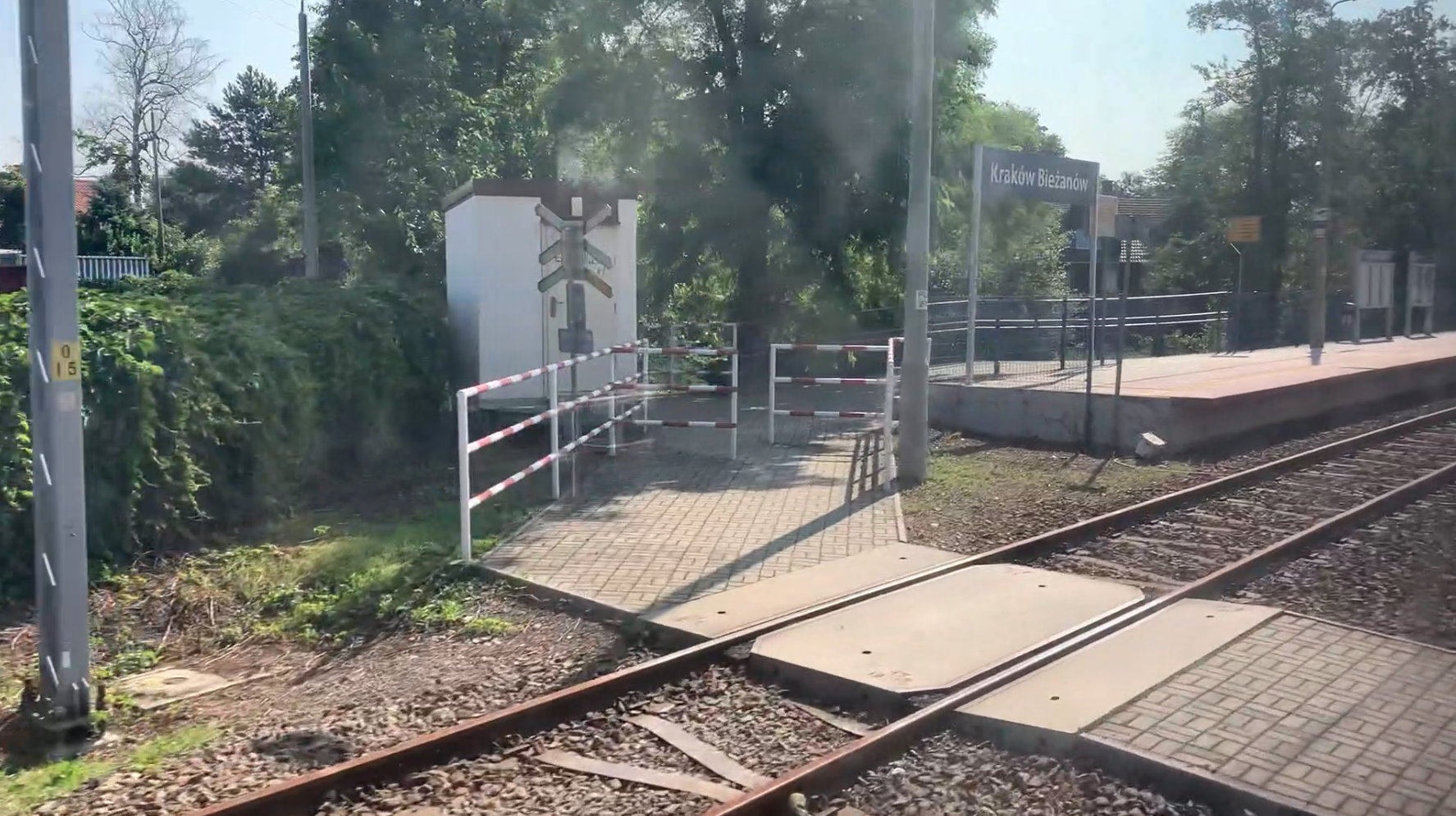
Wieliczka Rynek railway station.
The Wieliczka Rynek passenger stop operated in the period from 1927 to 2010. The platform was located between Adam Mickiewicza Street and the intersection of Powstania Warszawskiego and Księdza Zygmunt Goliana Streets. The platform was of a low type with an asphalt surface. The platform height was about 0.40 m above the rail head. There were three roofs with simple benches on the platform. There was lighting in the form of street lamps. The support goat was located at the very intersection of Powstania Warszawskiego and Księdza Zygmunt Goliana Streets. But there was a period, even before the electrification of the line, when the railway tracks crossed the intersection and the present “Kościuszko Square” park and ended next to the “Regis Shaft” mine building. In the pavement, a fragment of the railway track has been preserved next to the shaft.
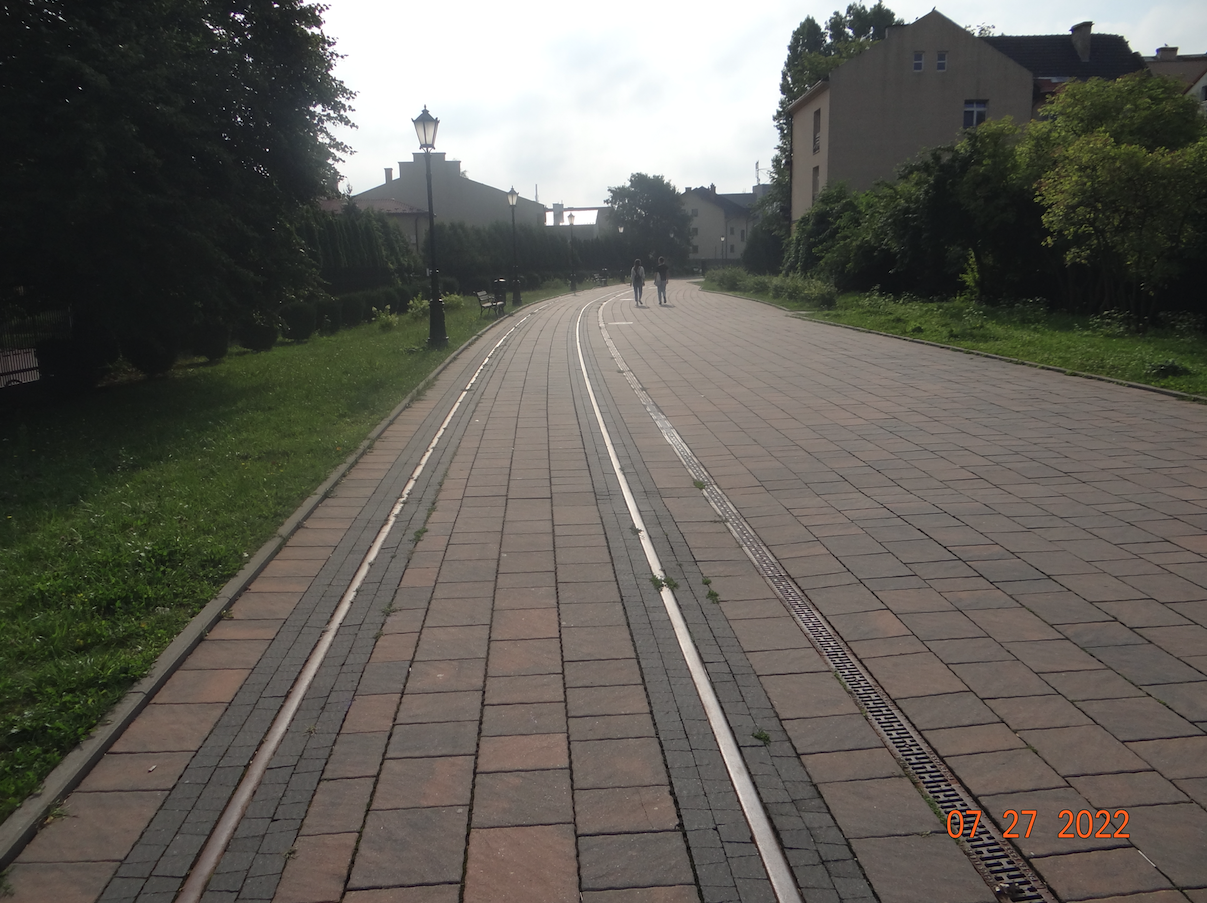
The first station building was opened in 1927 and was an adaptation of a small barrack. The new station was built in 1960, during the electrification of the route. The station was in the form of a pavilion with a waiting room and a ticket office. Currently (2022), the building still exists, but serves only commercial and gastronomic functions.
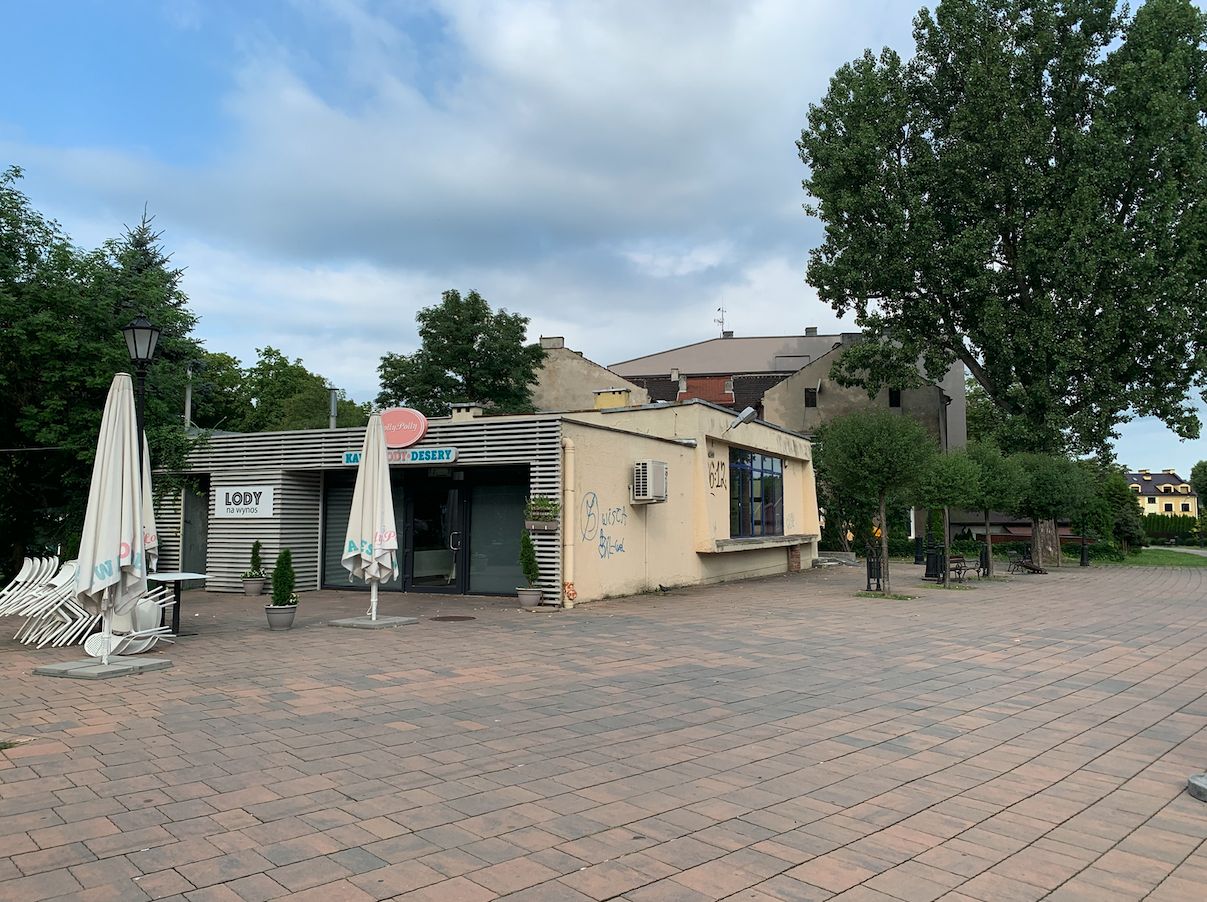
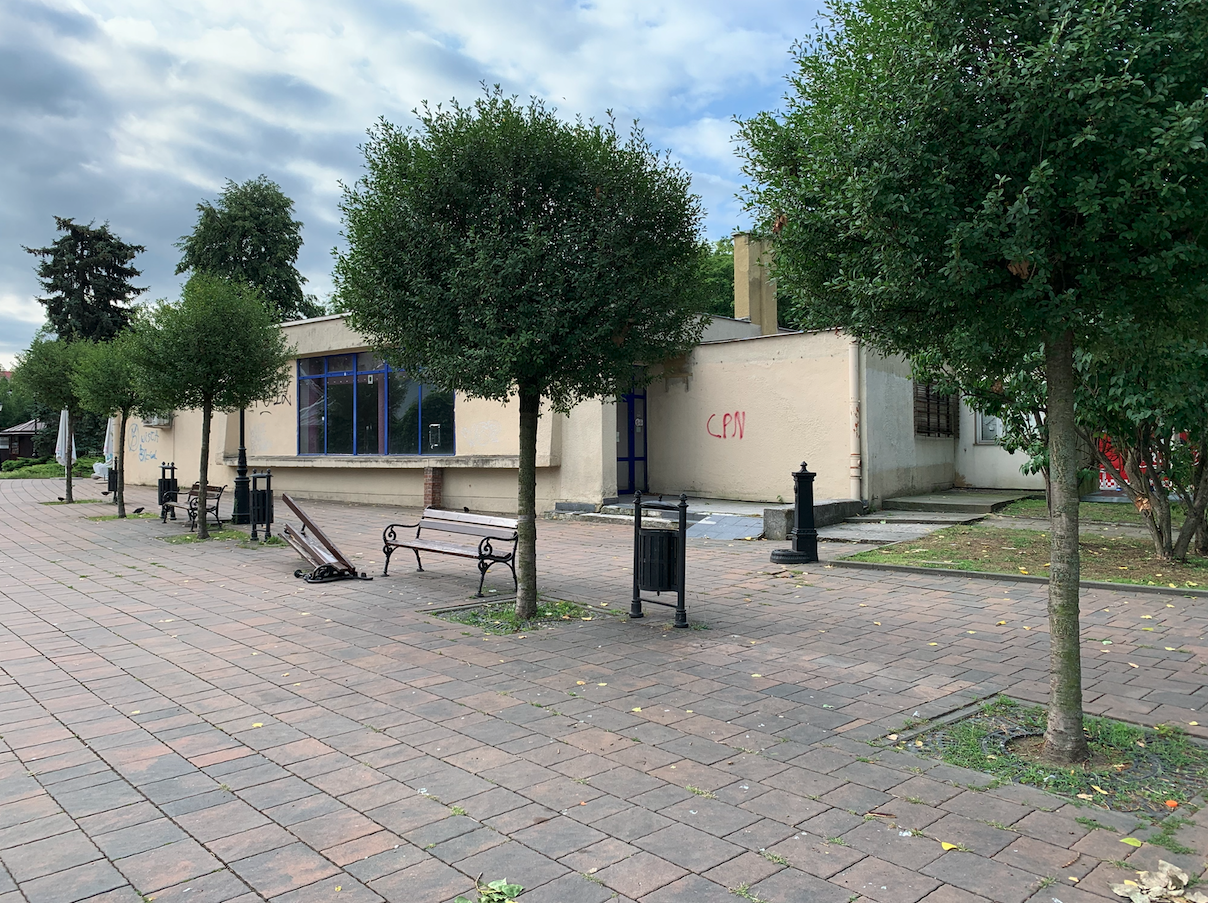
The Wieliczka Rynek station was closed after a failure in the "Wieliczka" salt mine in 1992. There was a huge leak in the mine and the mine was in danger of being flooded. Fortunately, the situation was under control after many months. Trains ran only to the former station, which was then called Wieliczka, and now Wieliczka Park. The track was in danger of being destroyed due to a failure in the mine. After a few years, traffic to the Wieliczka Rynek station was restored, but the trains ran very slowly.
In the period 2005 - 2009, Retro trains with historic electric locomotives, such as the EP03, sometimes ran to the Wieliczka Rynek station.
Currently (2022), the former Wieliczka Rynek station does not have a platform or a typical track. Reconstruction was made in 2014. There is a promenade here, which is part of the "Salt Route". The rails of the former track are left in a very nice sidewalk. In the period 2020-2022, an exhibition with photos from the former Wieliczka was placed on the course. This route takes you to the next Wieliczka Park station.
Written by Karol Placha Hetman
